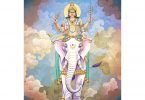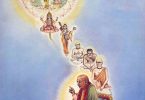Question: One answer I have heard as to why Rama sent his beloved and pregnant wife Sita to reside with Vamiki in his ashram was “As the ideal king, Rama was setting the example of a ruler placing the interests and contentment of his citizens above his own happiness.” (See Chaitanya Charan’s explanation below).
Doubt: If Lord Ramacandra descended to be an example of how to rule, then the situation of sending Sita away due to gossip is confusing. Rumors were simply gossip, and Lord Rama knew of Sita’s innocence. If the explanation above is the reason for Rama’s sending Sita away, He is setting the example that even if a woman is innocent, you would treat her the same as if she were guilty if there is gossip about her. This would be a dangerous example to set for those that rule.
How to answer this doubt? Is it not sufficient to say that this was their Rasa, their love in separation? Are there additional explanations, particularly ones which dharmic persons can relate to?
Answer by Romapada Swami:
Sri Govindaraja has noted in his introduction to Chapter 5 of Bala-kanda that the author of the Ramayana has described how Lord Rama separated Sita-devi from Him in order to describe His supremely compassionate nature.
It is a basic principle that the common people do whatever the leaders do (Bhagavad-gita 3.21). It is another basic principle that only the intelligent can distinguish between following and imitating powerful leaders (Srimad Bhagavatam 10.33.31). It is described in Canto 7 of this great book that since some less intelligent people in Rama’s kingdom misunderstood the mother of the universe Sita and began to take advantage of her life to indulge in sinful activities, the gravely thoughtful Rama, the very personification of dharma, decided to sacrifice His association with His most beloved Sita for the sake of steering His citizens, who were like His sons and daughters, towards the right track of auspiciousness. That is the point brought out in the commentary above.
Another point of consideration is that Sita-devi is more merciful than Rama and as such she would not have been able to tolerate the misconceptions and criticisms of her character by her own subjects because Sita-devi also loved the citizens like her children. It should be noted that when Indra’s son in the form of a crow bit her, she didn’t even complain about it to Rama, and she forgave the raksasis who had tormented her and protected them from Hanuman’s fury.
Rama knew Sita’s nature very well and so protected her from having to hear such cruel words. By the arrangement of Lord Brahma and Narada, two pure devotees of Sita-Rama, the entire Ramayana was then arranged to be composed by a neutral third party, Valmiki, an acknowledged authority absorbed in samadhi, in order to enlighten the citizens of Ayodhya about the truth of Sita’s character. The project succeeded: towards the end of the Ramayana, the citizens realized their error and wanted her to return.
This is the duty of a dharmika king who is expected to love His subjects like His own children. If one’s children begin to doubt the chastity of their chaste mother, it is the duty of a righteous father to do all that it takes to enlighten them.
Further Answers
A. Sri Vaisnava’s explanation as to why Sita was sent off to the forest during her pregnancy
-
- She desired to have her delivery in the forest amongst the sages
- This is due to the offence she committed against Lakshmana in the forest using heavy words. The Lord can forgive offences committed towards Him, but He can’t tolerate when offence is committed to His devotees; even if it is Goddess of Fortune, she has to pay for it.
B. Shubha Vilas Prabhu’s 12 explanations – (looking at this Q from Sita’s angle, from Rama’s angle, from the citizens’ point of view, from Luv and Kush’s point of view, from a conventional ethical point of view, etc.)
The first reason is the ethical dilemma wherein whatever one does has plus and minus features. For example, whether a young man chooses to continue his job to maintain his family, or whether he chooses to quit his job to be with his aging and ailing mother – that’s his choice. While others may favor one decision over the others, each choice has its favorable and its unfavorable aspects. Nobody else can say that he’s right or wrong. Each of us must make choices based on intuition.
The second reason can be illustrated by the following example. Consider two leaders – one leader sacrifices his family for the sake of the nation, and the other leader sacrifices the nation for the sake of his family. Either way, people will criticize. Leadership means responsibility, responsibility means sacrifice, and sacrifice means crying. A country where the leader cries (or sacrifices for the nation), the followers are happy – and a country where the followers cry (or sacrifice for the nation), the leaders are happy. Rama-raja is based on leaders making sacrifices for the citizens. The leader’s family is also making sacrifices.
The third reason is from Sita’s perspective. If you study divorce cases today, most of the divorce cases are such that when one of the persons gets custody of the children, whoever gets custody, the children begin to hate the other party. If the mother gets possession of the child, then the mother tells all the bad things about the father, and the child begins to hate the father. If the father gets possession of the child and the father tells all the negative things about the mother, then the child hates the mother. If you look at Sita’s banishment from Her point of view, Luv and Kush, who were Sita and Rama’s children, didn’t develop hatred for their father. They had deep love and respect for their father, which essentially means that Sita was not hurt. If she was hurt, she would have definitely instilled that hurt in her children also, or at least it would have rubbed off. We don’t find Luv and Kush hating Rama, but rather they loved Rama. Sita had two roles to play. She had the role of a wife and the role of a queen. As a wife, she was hurt. As a queen, she knew the decision was right. Being a queen, she never developed hatred.
The fourth is the story of Bhrgu Muni. When Sukracharya had gone for tapasya, the demons were taking shelter in Bhrgu’s ashrama. Graciously, Bhrgu and his wife were taking care of the demons. When the demigods attacked the demons, Khyati, the wife of Brghu, actually was helping to save the demons. She almost was going to kill Indra. Before she could do that, Lord Vishnu came and intervened and He cut off the head of Bhrgu’s wife, Khyati. When Bhrgu saw that he was separated from his wife, he became so hurt that he cursed Vishnu. “Just as I became separated from my wife, Vishnu will also be separated from His wife at some point.” Bhrgu was also the one who gave the curse that Vishnu will have seven births on Earth. Experience teaches us that, when you do some good, there tends to be some repercussion in your personal life. While doing good for others doesn’t necessarily directly bring pleasure, it brings you the byproducts of sacrifice – often, in the form of repercussion.
The fifth reason is Vipralambha Bhava – love in separation, which is what we very clearly understand. Rama and Sita experienced 10 months of Vipralambha Bhava when Sita was kidnapped. That Vipralambha Bhava, or mood of separation, was so intense that they wanted to experience it again. That was one of the reasons why the banishment happened.
[In NOD Chapter 44, we find the following passage: “Conjugal love is divided into two portions:
vipralambha, or conjugal love in separation, and sambhoga, or conjugal love in direct contact.
Vipralambha, separation, has three subdivisions, known as (1) pūrva-rāga, or preliminary attraction, (2) māna, or seeming anger, and (3) pravāsa, or separation by distance.”
The Ramayana has these 3 subdivisions of vipralambha. The specific pastime of sending Sitadevi to the hermitage of Valmiki could be considered pravasa, separation by distance (and therefore by time).
The means employed by the Supreme Lord’s internal potency might not be logically understood. These means are beyond mental and intellectual perceptions. They are meant to encourage us to take the necessary leaps of faith beyond rationality.
The sixth way of looking at this episode is from Rama’s point of view. Consider: Rama never remarried. In fact, He kept a golden statue of Sita next to Him. During all the yajna performances engaged in for 11,000 years, He always kept that golden statue by His side. Consider: if Sita was impure, then why would He have Sita’s statue next to Him while doing sacrifices? That means Rama considered her to be pure because to perform sacrifices, one has to be pure. Not only did Rama consider her pure, but she was pure enough to participate in sacrifices. That was what Rama was deliberately indicating by having the golden statue of Sita next to Him in every sacrifice that He performed.
The seventh understanding, the way I look at it, is that there are two types of dilemmas. There is an ethical dilemma where both options are right. There may be a moral dilemma where one option only is right. In ethical dilemmas, the decision is based on what leads to a greater good. Being a husband is right and being a king is right. The question in ethical dilemmas is “Which decision leads to greater good?” Is the decision of Rama being a husband more important? Or is the decision of Rama being a king and doing what is needful more important? From the point of view of a husband, if He had done the right thing by not banishing Her, He would have definitely done a good thing as far as being a husband is concerned. However, from a “greater good” point of view, not banishing Sita could have caused a greater bad than a greater good. So, He chose, from His vantage point, the “greater good.”
The eighth way of looking at the grounds for Sita’s banishment is this. When you’re dealing with rumors, how to respond is very difficult. Rama could have used His powers to crush the opposition. That could have increased the opposition. Consider how rumors work; the more you try to crush the rumor, the more it increases. If Rama had tried to crush the rumor, it would likely have only escalated. Instead, from a realistic point of view, Rama didn’t banish Her; He sent Her to Valmiki’s ashrama. Valmiki’s ashram was within the kingdom of Rama. It was not outside the kingdom of Rama. It was close by. She was not technically an exile; rather, He ensured Her protection and comfort. He didn’t abandon Her, but He entrusted Her in Valmiki’s care. In fact, if you study Bhavabhuti’s Uttara-rāmacarita, which is a Sanskrit drama, Bhavabhuti gives a very interesting explanation that Sita expressed Her desire to go to Valmiki’s ashram during Her pregnancy. Rama used that as a pretext, or rather a context, of sending Her to Valmiki’s ashrama. According to Bhavabhuti (within Uttara Kanda of Valmiki Ramayana, Sita specifically requests Rama to again spend time in the forest with the sages, after they return to Ayodhya), Sita herself was the source of Rama’s idea of sending Her to Valmiki’s ashram.
The ninth reason is in Madhvacharya’s tatparya-nirnaya. Here, Madhvacharya talks about a demon who got a benediction that for as long as Lakshmi and Narayana are united, I cannot die. He thought that Lakshmi and Narayana could never be separated; for this reason, the demon requested this benediction. While Rama was separated from Sita, Indra killed that demon. Then, Rama had planned, He would call Her back. Eventually, however, Sita decided to enter into the Earth. If you look at it from the heavens’ point of view, it was a few days, but that became a few years from the Earth’s point of view.
The tenth reason was Sita was known as dharma-charini tava. If you carefully study Sita’s marriage ceremony, when Janaka handed over Sita to Rama, He explained to Rama that She is dharma-charini, which means that She will speak when She feels that something is wrong. If Rama had done anything wrong, surely She would have spoken. On many occasions, Sita spoke this way. For example, when Rama was going to the forest and not taking Her along, she actually blasted Him. She was very outspoken at that point. When She understood that Rama had vowed to slay the Raksasas in the forest, She preferred Him to be in a more peaceful disposition. She very clearly told Him that You appear to be too much power hungry. She actually chastised Him. If Sita had felt that it was wrong for Rama to send her to Valmiki’s ashram, She would have spoken up. She was not somebody who wouldn’t speak. That is the tenth understanding.
The eleventh understanding: Technically, Rama was not concerned about His reputation. If He had been concerned about His reputation – then as Krishna, who is the same Rama, would not have married 16,000 girls who were kidnapped by Banasura. In the Ramayana, the reality is that Rama and everyone for whom He is setting the example placed their personal interest lower than the interest of others, for the sake of others.
The twelfth reason is found in the Patala Kanda of Padma Purana. There you will find the story of two parrots. These two parrots were speaking about the marriage of Sita and Rama. This occurred when Sita was just a small girl in Mithila, still unmarried. She was very intrigued to see if these parrots were speaking the truth. So, she caught the female parrot. She put the female parrot in a cage. The male parrot was really, really suffering a lot in separation from the female parrot. Nonetheless, Sita kept the female parrot. The female parrot was pregnant. The female parrot told Sita that “I am pregnant, please allow me to be with my husband.” Sita said “Until I find out if I am actually going to get married to Rama and who this Rama is, I won’t let you go.” Sita kept that female parrot with Her. That female parrot cursed Sita that She will also become separated from Her husband when She is pregnant. That was another reason why this separation happened.
Chaitanya Charan das –
Question: In the Ramayana, when Sita was wrongly accused by a washerman, why did Lord Rama banish her?
Answer: Firstly, Lord Rama never banished mother Sita. Banishment implied being evicted out of the kingdom into the forest without any arrangements for food, clothing, or shelter. That was what happened to Lord Rama when he was banished by his step-mother, Kaikeyi. But Lord Rama asked Lakshmana to escort Sita to the hermitage of the sage Valmiki, where the venerable sage received her with a respectful aarti (worship) and the elderly lady-hermits lovingly cared for her. As the hermitage was in the kingdom of Lord Rama and under his protection, it’s entirely incorrect to say that the Lord banished Sita, for the Lord indirectly arranged for her food, clothing, shelter, and care.
Now we may ask: why did the Lord send Sita out of his palace into the hermitage?
To understand the answer, we need to appreciate the values held sacred by the Vedic culture that the Ramayana demonstrates. The Vedic culture considers all relationships and all positions as opportunities for sacred service, service to God and to all his children. When Lord Rama heard the accusations being leveled against his consort, this situation constituted an ethical crisis. In an ethical crisis, one has two choices, both moral, unlike in a moral crisis, when one has two choices, one moral and the other immoral. To resolve an ethical crisis, one needs profound wisdom to recognize the higher moral principle and adjust the lower moral principle accordingly. So, through this incident, Lord Rama, who was God incarnate playing the role of an ideal human being, taught us how to wisely resolve ethical crises. As an ideal husband, the Lord was duty-bound to protect his wife. But as the ideal king, he was also duty-bound to exemplify and teach his citizens, whom he loved like his own children, the path to spiritual advancement. Ordinarily, people are very attached materially to spouse, children, house, wealth. So, the king is duty-bound to demonstrate to his citizens the principle of detachment so that they become inspired toward detachment and thus make spiritual advancement. That’s why Lord Rama considered his duty as an ideal king more important than as the ideal husband and so sacrificed his love for his wife for the sake of his love for his children (citizens). But he didn’t abandon his duty as a husband; he thoughtfully did that duty by transferring Sita from his direct care in the palace to his indirect care in the hermitage. Mother Sita, understanding the heart of her Lord, gracefully accepted her part in his sacrifice.
Unfortunately, all of us, for whose sake he did this glorious sacrifice, fail to appreciate him.







